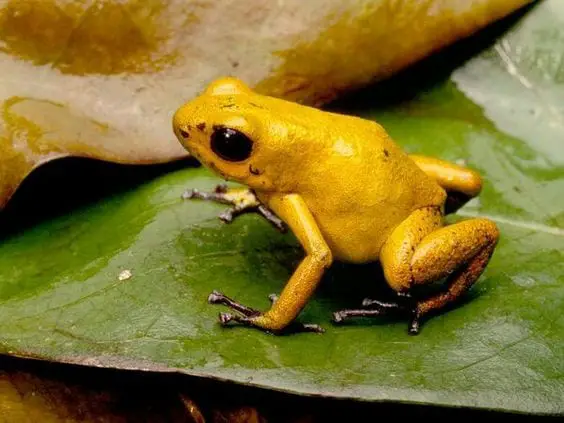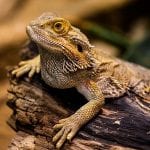Frogs are known to be docile, cute creatures that we may have had as pets. We see frogs every day, in our gardens, lawns, and yards. Frogs are also common in ponds, parks, and even in highways, in human areas. But do you know that there are dangerous frogs that you cannot take home as pets? Here are eight of the most spectacular but dangerous frogs.
1) Golden Poison Dart Frog
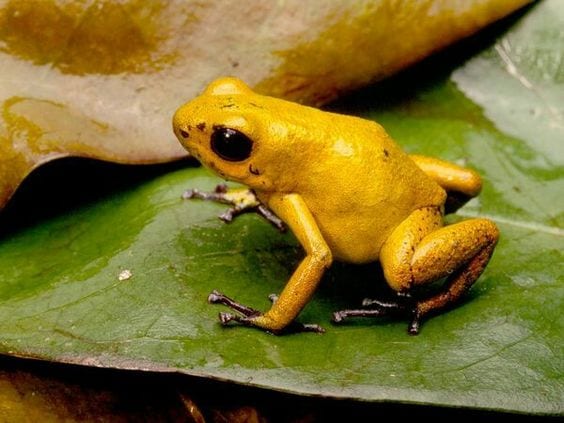
The Golden Poison Dart Frog has a very dangerous poison that it uses only for self-defense. This frog contains batrachotoxin, a very intense poison that can kill up to 10 adult men in just a few seconds. If you touch this frog with your bare hands, you can become paralyzed and even die because this can easily penetrate the bloodstream.
The color of this frog serves as a warning because it is golden yellow with black toenails. Do you know that in 1978, local folks used the Golden Poison Dart Frog as a weapon? They dipped the sharpened ends of their darts in the skin of this frog and used these darts to kill their enemies.
The Golden Poison Dart Frog (Phyllobates terribilis) is native to the Pacific coastal areas of Columbia. It lives in the rainforests with higher incidences of rain at around 5 meters or more in a year. These habitats are from 100 to 200 meters, temperatures of 26 degrees Celsius, and an RH of 80 to 90%.
The Golden Poison Dart Frog is a social animal when in the wild. It can be found in groups of six eating, playing, basking and swimming about. But in captivity, Golden Poison Dart Frogs can live in larger, happier groups.
Captive Golden Poison Dart Frogs are considered not harmful because of their size and their lovely bright colors. But in the wild, this is considered a lethal animal, and anyone who sees it should stay away.
What does the Golden Poison Dart Frog look like?
The Golden Poison Dart Frog is known as one of the largest species of poison dart frogs. This can grow up to 55 mm. Females are larger than males. Just like all dart frogs, adult Golden Poison Dart Frogs have very bright colors but don’t have the black or dark spots that are found in many dendrobatids. The color of the Golden Poison Dart Frog serves as a warning, telling other creatures that it is poisonous.
Under the toes are adhesive disks, and it uses these disks to climb on plants. It may also seem that it has teeth, but this is a bony plate found in its lower jaw. This feature is not present in other species of the genus Phyllobates.
The Golden Poison Dart Frog is diurnal and has three different varieties based on color morphs: mint green, yellow, and orange.
Captive care
Just like all poison dart frogs, the Golden Poison Dart Frog will no longer be toxic when it is raised in captivity or away from its food source. This species is one of the easiest to care for because these will eat anything that they see like crickets, small mealworms, waxworms, and termites.
This frog is sensitive to extreme heat and can suffer from wasting syndrome if it becomes overheated. This needs high humidity because these are from some of the most humid rainforests on the planet. You can also find Golden Poison Dart Frogs in zoos and nature reserves.
2) Lovely Poison Frog
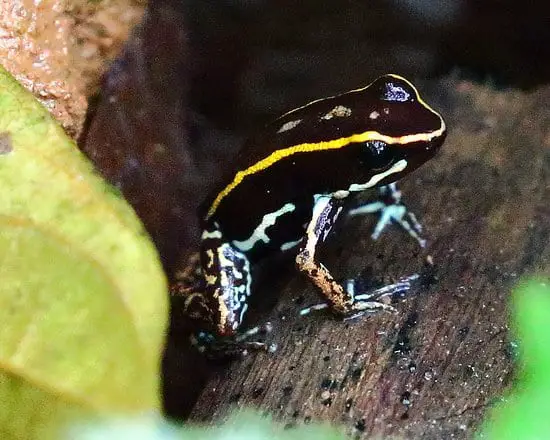
The lovely poison arrow frog (Phyllobates lugubris) is a species belonging to the Dendrobatidae family. The appearance alone of this small frog indicates that it is toxic, lethal, and likely to cause devastating effects. This poison arrow frog is native to the Caribbean area of Central America. Groups from the Pacific area includes the lovely poison frog.
What does a lovely poison frog look like?
A lovely poison frog adult male can grow up from 18.5 to 21 mm from snout to vent. This frog has maxillary teeth and has a black dorsum with stripes running from its head to the back. The stripes can be yellow to orange or gold.
The lovely poison frog has limbs that are mottled with yellow to yellow-green color. Its ventral surfaces come with extensive pigment; sometimes, the back may look like its solid black. You will only see the mottled appearance when you inspect the skin closer.
Lovely poison frog poison
The poison of the lovely poison dart frog is known as the least toxic of all the Phyllobates. The skin of the lovely poison dart frog can secrete pumiliotoxin A, which is the most lethal of all the pumiliotoxins. This toxin can block the contraction of the muscles, including the heart. The victim can suffer from cardiac arrest as well as respiratory failure. The lovely poison dart frog has high levels of pumiliotoxin for a small frog, and therefore, just a mere touch of a wild lovely poison dart frog can lead to deadly, life-threatening effects.
Pumiliotoxin in high amounts can be deadly, but it is weaker compared to allopumiliotoxin, such as batrachotoxin. There are three known types of pumiliotoxin: A, B, and C with A and B more toxic than C. Symptoms of pumiliotoxin toxicity include partial paralysis, difficulty in moving, hyperactivity, and death.
Captive care
The lovely poison frog is not commonly cared for as pets, but some who have had the luck of taking care of this frog recommend using a large terrarium. A large terrarium is important rather than a tall one because this frog doesn’t climb or jump a few inches from the ground.
The lovely poison frog requires a terrarium with high levels of humidity with temperatures from 25 to 28 degrees Centigrade. Most lovely poison frogs are solitary, but captive ones tend to become sociable.
3) Golfodulcean Poison Frog
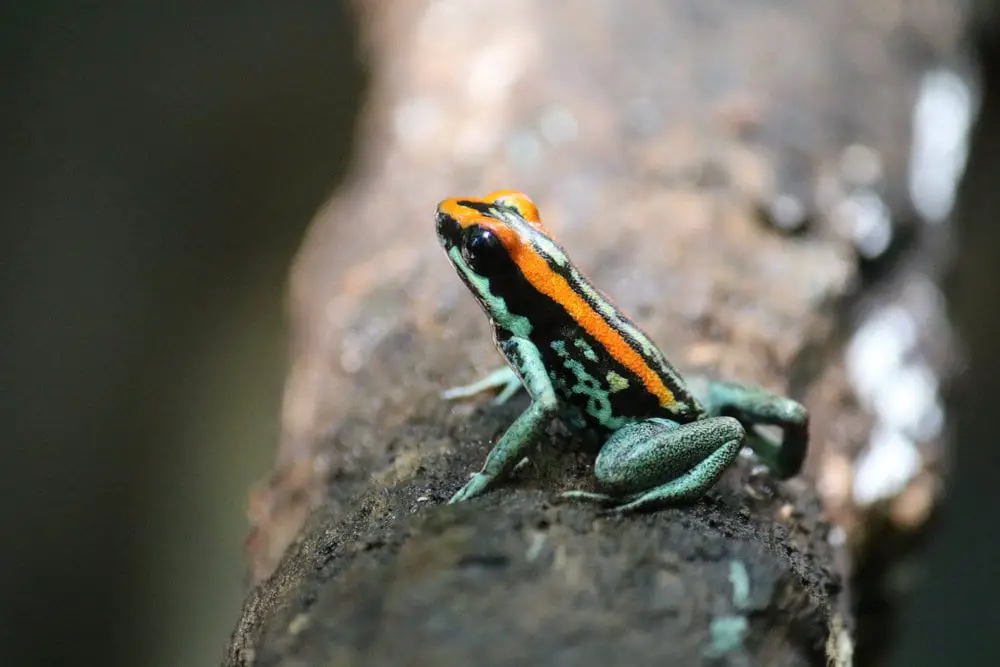
The Golfodulcean poison frog is also known as the Golfodulcean poison-arrow frog is a frog species belonging to the Dendrobatidae family. This colorful but lethal frog is native to Costa Rica. It is currently classified by the IUCN as endangered.
What does a golfodulcean poison frog look like?
The Golfodulcean poison frog is a large frog that can grow up to 3 cm. Female frogs are larger than males, just like other frog species. The Golfodulcean poison frog has a smooth body compared to other species with perfect sloping backsides. The frog may look overweight, but this is due to their shoulders not visible from the skin.
The Golfodulcean poison frog is black but may shine because of the different chemicals in the skin. It has mottled blue legs, with sides that have a blue marble pattern while some may appear green. The most stunning features of this frog are the stripes that run along its back, and this is why it’s so named. The two stripes are fire-orange but may also appear green, yellow, or gold. The stripes extend from above the cloaca towards the nose of the frog.
Golfodulcean poison frog poison
The Golfodulcean poison frog’s poison is neurotoxic. This frog is only the fourth most-toxic member of the genus Phyllobates, but despite this, it is still a very poisonous animal. The poison of the Golfodulcean poison frog can cause extreme pain and then followed by seizures known as tonic-clonic seizures. If a large dose of toxin is administered, the victim can suffer from paralysis.
Wild frogs can store large amounts of neurotoxin on its skin; however, captive Golfodulcean poison frogs don’t have the toxin. This could only mean that this frog does not manufacture the poison but rather get it from the food that they eat, such as a species of invertebrates and insects.
Up to this day, scientists are still unaware of the source of the batrachotoxin for the Phyllobates. However, toxic birds that are native to New Guinea acquire their batrachotoxin from a tiny beetle that belongs to the Melyridae family.
Captive care
The Golfodulcean poison frog is a communal animal and, very recently, has become a popular pet. In captivity, this frog can be kept in a terrarium that measures 100 x 60 x 60 cm to provide the frog’s room to move on the ground and enough height to climb.
The ideal substrate for this frog could be leaves, but you must be careful that the leaves you place are clean and free from pests and parasitic fungi. The Golfodulcean poison frog climbs the terrarium by using their toe pads with extra adhesive capabilities, just like geckos. As much as possible, seal the top of the frog’s enclosure to prevent escape.
4) Kokoe Poison Frog
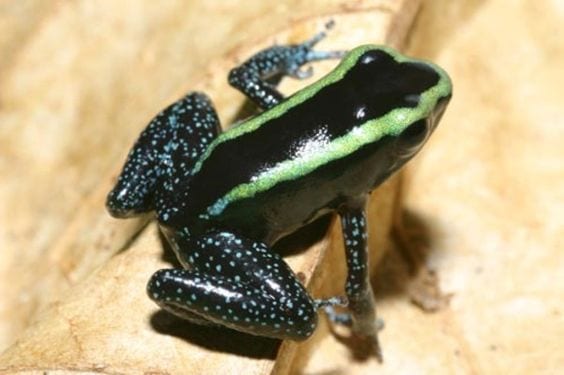
The Kokoe poison dart frog is a lovely dark frog with a terrible poison. It is a species of poison dart frog that is native to northern Colombia near Panama. This is known as the 4th most toxic frog of its genus. At present, the Kokoe poison dart frog is threatened by pollution, habitat destruction, and an infectious disease known as chytridiomycosis.
What does a Kokoe poison frog look like?
The Kokoe poison dart frog is a medium-sized poison dart frog with males growing up to 3 cm in length. Females are slightly bigger than males and may grow up to 3.2 cm in length. Just like most dendrobatid species, this poison frog has a lovely color and patterns. It is usually black, but the Kokoe poison dart frog has yellow or green stripes along its dorsal area, from the nose to the back. The Kokoe poison dart frog has dark brown to black legs with white dots. The belly of the frog is black.
Kokoe poison frog poison
The Kokoe poison dart frog is known as the 3rd most toxic of all the poison dart frogs. The poison is known as allopumiliotoxin 267A from its skin like other members of the genus lugubris. And aside from this dangerous toxin, the Kokoe poison dart frog also secretes batrachotoxin.
The Kokoe poison dart frog is very toxic. Just touching a stressed adult can cause very serious and mostly life-threatening neurological symptoms such as loss of muscle, high fever, convulsions, and paralysis. A large animal that eats an adult Kokoe poison dart frog may die immediately. Wild Kokoe poison dart frog is very toxic, but captive specimens don’t have toxins, which may suggest that these frogs ingest food that leads to this toxicity.
Captive care
Kokoe poison dart frogs can be a good beginner vivarium pet. Take note that this is a very active animal and thus may climb up the wall of the enclosure or may jump out if it can. Kokoe poison dart frog is very social, so you need at least three or more frogs in an enclosure.
Kokoe poison dart frogs need an enclosure with high humidity and cooler temperatures. When feeding, use larger prey compared to other poison dart frogs. This species may engage in “wrestling behavior” however, this is not as frequent as other poison dart frog species.
5) Blue Poison Dart Frog
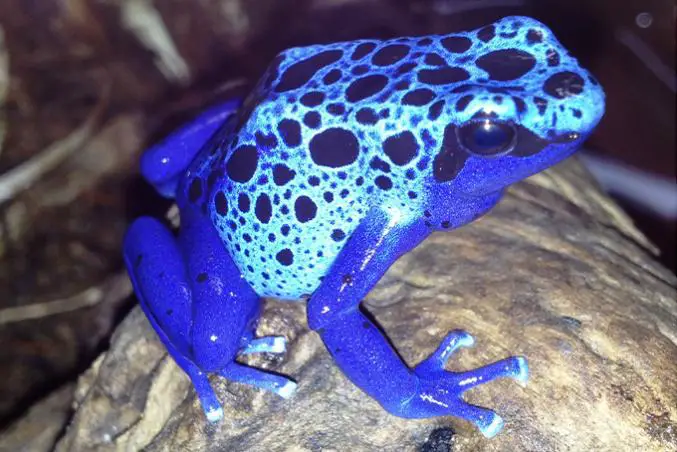
The blue poison dart frog (Debdrobates tinctorius “azureus”) is one of the poison dart frogs that are found in the forests near the Sipaliwini savanna in southern Suriname and the northernmost parts of Brazil. This frog is a mainland animal; however, it remains close to sources of freshwater.
The blue poison dart frog is very territorial and aggressive towards frogs of the same species and other species as well. And to keep intruders away, this frog uses calls, wrestling, and chasing. Their skin toxin is used by natives to coat the tips of their arrows with a deadly toxin.
What does a Blue Poison Dart look like?
The blue poison dart frog is a medium-sized fog that can grow from 3 to 4.5 cm and weigh up to 8 grams. The female of the species is larger than the males, but males have larger feet and toes. A blue poison dart frog can live up to 7 years in the wild and can live longer in captivity.
The blue poison dart frog has bright blue skin with black patterns. The limbs and stomach have a darker blue color. This frog uses its color to ward off threats. The spots are different from one specimen to another, and thus, you can identify one frog from the other. Each of the foot of this frog has 4 toes, and each of the toes has a suction cup that the frog uses to grip the walls of the terrarium and the accessories inside the tank.
Blue Poison Dart poison
The poison of the blue poison dart frog is made of poisonous alkaloids that are excreted from the frog’s glands located on its skin. The poison of this frog is enough to paralyze and even kill a predator or a threat by merely touching its skin.
The skin toxin of this frog is used to arm the tips of the arrows of native people. However, captive blue poison dart frogs lose their toxicity, which means that their natural diets may have contributed to their toxicity.
Captive care
In captivity, the blue poison dart frog should be kept in a large and tall tank. This frog needs a large area to roam around and socialize. It prefers to live with two or more frogs of the same species. You must also choose a tall enclosure because this frog can easily leap out of its enclosure after climbing the top of a tall plant or accessory.
6) Strawberry Poison Dart Frog
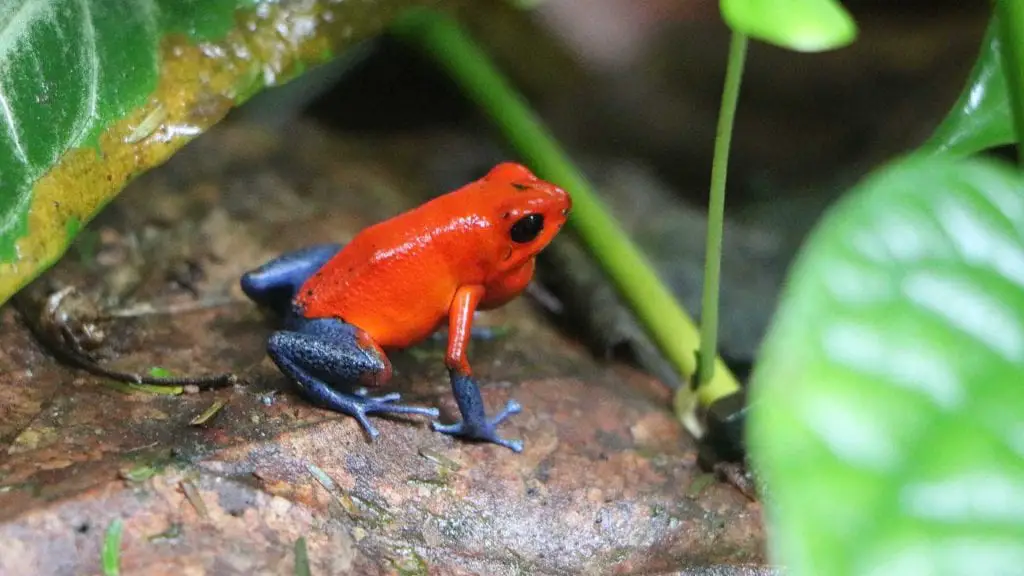
The strawberry poison dart frog (Oophaga pumilioi) owes its name from its stunning bright red body. It is a small poison dart frog that’s native to Central America. It favors humid areas and premontane forests. Large numbers may also be found in plantations and other disturbed areas. This frog is the most poisonous of its dendrobatids. It is also the most toxic of all the members of its genus Oophaga.
What does a Strawberry Poison Dart look like?
The strawberry poison dart frogs us small and slender frogs that have bilateral symmetry. It can grow from 17 to 24 mm and have four un-webbed fingers on each foot and hand. It has a compact body with very large dark eyes.
The skin is moist and makes it look glossy, especially in the daytime when light shines on the skin. Aside from the red, you can also find white, green, yellow, blue, black, and orange varieties. The back of the frog has dark spots. The legs are darker and have black mottling.
Strawberry Poison Dart poison
The poison of strawberry poison dart frogs is the type that can cause convulsions with the toxin able to interfere with regular heart function. Large doses of this poison can cause paralysis and can even lead to death. The strawberry poison dart frog also uses its lovely color to warn threats and predators of its toxin.
Captive care
The strawberry poison dart frog may be very lethal in the wild but are a darling in captivity. It loses its poison after being kept in captivity for a long time, which is proof that its poison could be from the food it eats from its natural environment.
You will need a large and tall enclosure or terrarium for a pet strawberry poison dart frog. The large area should be able to accommodate two or more strawberry poison dart frogs because these species enjoy communal living. A large cage also allows the frog to roam about and explore its surroundings. A tall enclosure is necessary to allow your pet to perch but seal the top because this frog can jump high once it has a secure footing.
7) Pickerel Frog
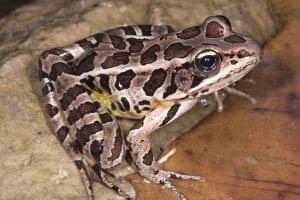
The Pickerel Frog (Lithobates palustris) may not be as toxic as the previous frogs on our list, but it can become feisty when threatened. This frog is a small frog native to North America, and it has classic squares that look like they were hand-drawn rectangular dark spots. These spots may blend to create a long and dark mark.
What does a Pickerel Frog look like?
The Pickerel Frog is a gray or tan-colored frog with 7 to 21 irregular spots. As mentioned, these spots can blend to form a larger and more prominent spot. These frogs have orange to yellow flash design along with the inner parts of its hind legs. The front toes of a Pickerel Fog are not webbed, and this helps the frog to survive in terrestrial life.
Pickerel Frog defense mechanism
This frog can emit a secretion that can irritate people and may even be toxic to some threats and predators. And because of this, the Pickerel Frog is the only poisonous frog in the United States. Because of its poison, most animals leave this frog alone. The secretions of a stressed Pickerel Frog can be very toxic to humans and other frogs.
Captive care
Pickerel Frogs may live in an enclosure with cool and clear water. You need to provide a large enclosure to house this frog if you intend to keep it as a pet. The diet is similar to other frogs. The Pickerel Frog will hibernate during the winter.
8) Budgett’s Frog
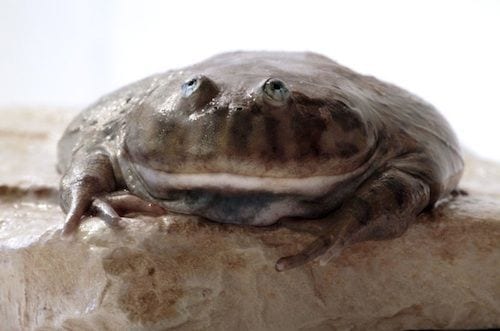
The Budgett’s Frog (Lepidobatrachus laevis) is mostly kept as a pet and is also known as Wednesday frog because of its sulky appearance. It has become very popular as a pet due to its flat appearance and intelligence. But unknown to most people, it has a nasty and dangerous behavior that you should be wary of.
What does a Budgett’s Frog look like?
A female Budgett’s Frog can grow up to 100 mm, and females can grow larger than males. This frog has a large head that seems to be larger than the rest of its body. This frog has a very large mouth with a row of teeth and two mini fangs. They have very short and stubby legs and arms.
Budgett’s Frog behavior
The Budgett’s frog has adapted to its natural environment, and during winter, it will become inactive and cover itself with dead skin. This is generally very aggressive, and this is when it becomes dangerous. It will puff up to grow bigger, and it will make a shrilling screech to ward off the threat. It will also bite and corner the threat.
Captive care
The Budgett’s Frog can be kept as a pet but only by experienced owners. It can be kept in a 10 to 20-gallon tank without using any aquarium gravel or sand because this can lead to digestive problems. This frog does not need additional heating and lighting because it is a nocturnal animal. This frog should only be kept alone because anything smaller than itself will be eaten.

